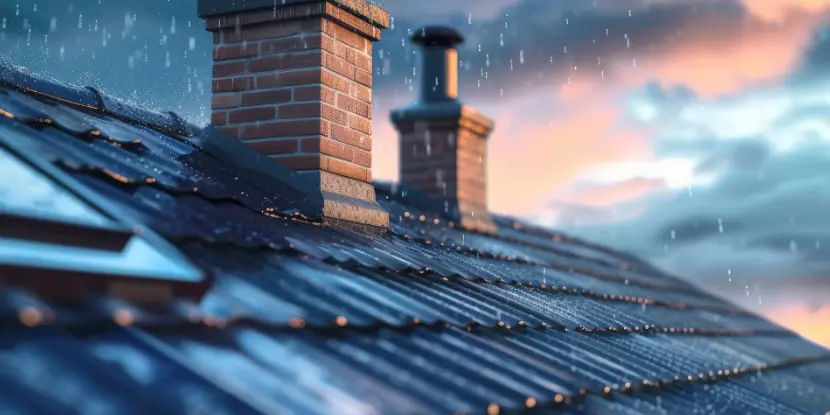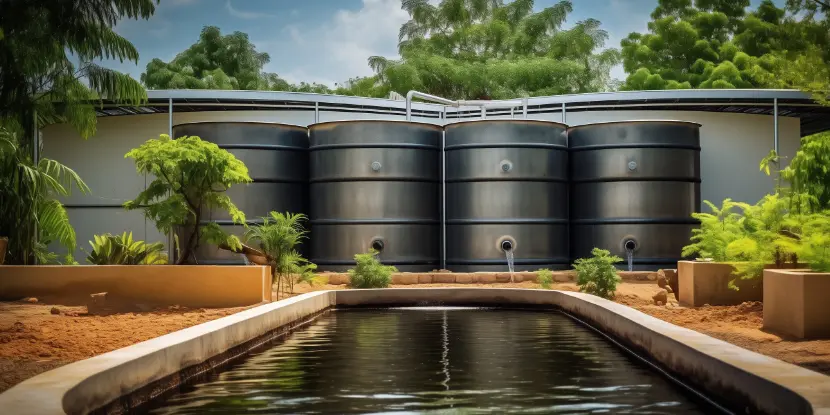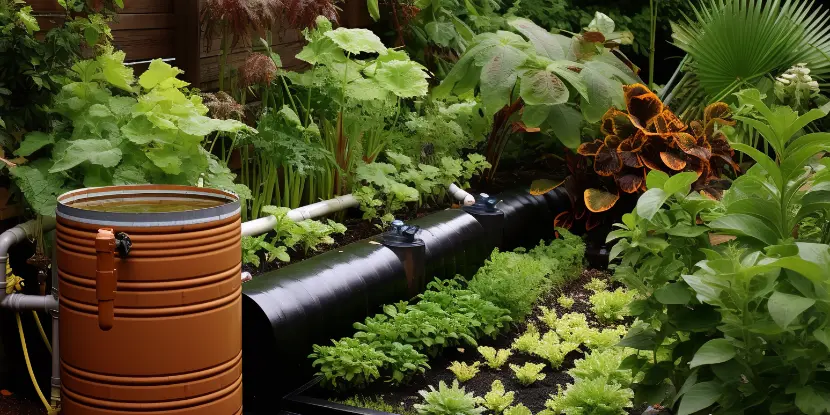Rainwater collection was legalized in California with the Rainwater Capture Act in 2012. Before then, permits were required and still are in many states.
But Californians are in luck! Even though gas is sky-high, and housing prices are through the roof, rainwater is free! And all you need to store it is an efficient rainwater harvesting system.
Why Collect Rainwater?
- Harvesting rainwater can reduce your water bill. You’ll be less dependent on municipal water sources.
- Rainwater is free from chlorine and other chemicals in tap water, making it better for irrigating plants and gardens.
- Collecting rainwater reduces runoff, decreasing erosion and pollution in our natural water bodies.
- Rainwater can serve as a backup water source during shortages or emergencies.

Watering the garden with collected rainwater.
What’s a Rainwater Collection System?
A rainwater collection system gathers, stores, and distributes rainwater from rooftops and other surfaces. It uses rainwater for non-potable purposes like irrigation, flushing toilets, and washing clothes. The components include:
- Collection Surface: Typically, the roof of a house or building serves as the primary surface for rainwater collection. The larger the collection area, the more rainwater can be captured.
- Gutters and Downspouts: These channel water from the roof into a storage system.
- First Flush Diverter: This device redirects initial rainwater, which may contain debris and contaminants from the collection surface, away from the storage tank.
- Storage Tanks: Tanks can vary in size and material, such as plastic, concrete, or metal.
- Filters: Filters remove debris, leaves, and other particulates from the water before it’s stored.
- Pumps and Delivery Systems: Pumps and a network of pipes can deliver the stored rainwater where needed.

Roofs offer a large surface for rainwater collection.
Planning Your Collection System
Careful planning ensures a successful implementation.
- Assess Water Needs: This could range from watering a small garden to supplying a household for non-potable purposes. Understand your average water use to determine your system’s capacity.
- Choose the Right Location: Select a spot where your storage tank will receive the maximum amount of water from downspouts while also being convenient for the water’s intended use.
- Calculate Roof Surface Area: Measure the area of your roof or collection surface. The rainwater you can collect is directly related to this surface area. To calculate, multiply the length by the width of each roof section that directs water to your collection system, then add these numbers together.
- Calculate Rainfall Amount: Research the average annual rainfall in your area to estimate how much water you can collect. Keep in mind that not all rainwater is captured.
- Determine Tank Size and Material: Based on your water needs and rainfall calculations, choose a tank size and material that fits your budget and space. Consider installation costs, durability, and the potential for leaks or contamination.
Materials & Tools
Materials
- Gutters and downspouts to channel rainwater from the roof to collection tanks.
- Collection tanks to store rainwater for later use.
- First flush diverter to separate the initial rainfall, which may contain debris and contaminants.
- Filtration system to remove debris and pollutants from collected water.
- Pump (optional) to pressurize water for distribution.
- Water pipes to transport water from the storage tank to its intended use.

An industrial rainwater collection system in an arid region.
Tools
- Tape measure
- Marking chalk or pencil
- Level
- Drill with bits suited for metal or plastic pipes
- Pipe cutter
- Saw
- Hammer
- Screwdriver
- Wrenches
Where to Buy Storage Tanks for Rainwater Collection
- Home Improvement Stores: Large chains often carry rainwater storage tanks in different sizes and materials. These are great for DIYers looking to start small or medium-sized projects.
- Specialty Suppliers: Companies specializing in rainwater harvesting systems offer professional-grade tanks that might have additional features, like improved UV resistance or insulation.
- Online Retailers: Specialized online stores dedicated to sustainable living often sell tanks and other components for rainwater collection systems.
- Local Agricultural or Co-op Stores: Local agricultural suppliers or cooperatives might sell large water tanks suitable for rainwater collection. These are particularly useful for more extensive systems intended for agricultural or large-scale residential use.

Large rainwater collection tanks.
Building Your Rainwater Collection System
- Install gutters and downspouts on your roof.
- Attach a first flush diverter to each downspout. This device should be installed between the gutters and the storage tanks. It redirects the initial rain, which may carry debris and contaminants from the roof, away from the storage tanks.
- Pipe the downspouts to the collection tanks. Ensure all connections are secure and free of leaks.
- Install the filtration system. Place filters where water enters the collection tanks. Consider additional filtration based on the intended use of the rainwater and local regulations.
- Set the storage tanks on a stable, level base to avoid structural issues. If your system requires it, connect multiple tanks to increase storage capacity.
- Install the pump system (if needed). A pump will be necessary to provide adequate water pressure for systems that use rainwater for irrigation or within the house (for non-potable purposes). Connect the pump to the storage tanks and then to the distribution network.
- Create a distribution network. Lay out pipes or hoses from the storage tanks to where the water will be used. This could be garden beds for irrigation, a connection to your home’s plumbing for toilet flushing, or outdoor faucets for general use.
- Test all components to ensure they work correctly together. Check for leaks in the tanks, pipes, and connections.

A small rainwater collection system for a garden.
Maintenance Tips
- Periodically clean your gutters, downspouts, and collection tanks to prevent clogs and contamination. Remove debris and sediment that may have accumulated.
- Check your system regularly for leaks or damaged components. Repair any issues promptly to prevent water loss and maintain system efficiency.
- If you live in a colder climate, take precautions to prevent your system from freezing. This could include installing insulation around pipes and tanks or draining the system entirely before winter.
- Monitor your rainwater collection system throughout the year to ensure it’s functioning correctly and meeting your water needs. Adjust or upgrade as your usage and needs change.
FAQs About Rainwater Collection Systems
Q: What’s the best location for a rainwater collection system?
The best location is near areas where you’ll use the water most, such as gardens or outdoor cleaning stations.
Q: How much does it cost to build a rainwater collection system?
The cost varies depending on factors like size, materials, and labor. A basic system can cost a few hundred dollars, while larger or more complex setups require a bigger investment.
Q: Can I drink rainwater collected from a collection system?
While rainwater is safe for non-potable uses like gardening and cleaning, we don’t recommend it for drinking without proper filtration and treatment.
Q: Do I need a permit to install a rainwater collection system?
In California, no. Regulations vary by location elsewhere, so check with your local authorities to determine if you need a permit before installing a system.
Q: How often should I clean my rainwater collection system?
We recommend cleaning your rainwater collection system at least once a year or more if you notice issues like clogs or contamination. Regular maintenance ensures optimal performance and water quality.
Q: Can rainwater collection systems be used during all seasons?
Yes, but they may require adjustments based on seasonal variations. In regions with cold winters, systems need to be winterized to prevent freezing, while in areas with dry seasons, storage capacity becomes critical to ensure water availability.
Q: How large should my rainwater tank be?
The size of your rainwater tank should reflect your water use, catchment area size, and local rainfall patterns. Assess your water needs and consult a professional to determine the optimal tank size for your circumstances.
Q: Is rainwater collection eco-friendly?
Rainwater collection reduces dependence on municipal water supplies, decreases stormwater runoff, and lessens the impact on local water resources. It’s a sustainable practice that conserves water and can mitigate the effects of drought in many regions.
Q: Can I use rainwater for indoor plants?
Rainwater is excellent for watering indoor plants. It’s naturally soft, free of chlorine and other chemicals in tap water, and can be better for plant health.
Q: What is the impact of rainwater harvesting on my property value?
Rainwater collection is a commitment to sustainability. Properties with eco-friendly features are becoming more desirable in many markets, potentially making your home more attractive to buyers.

